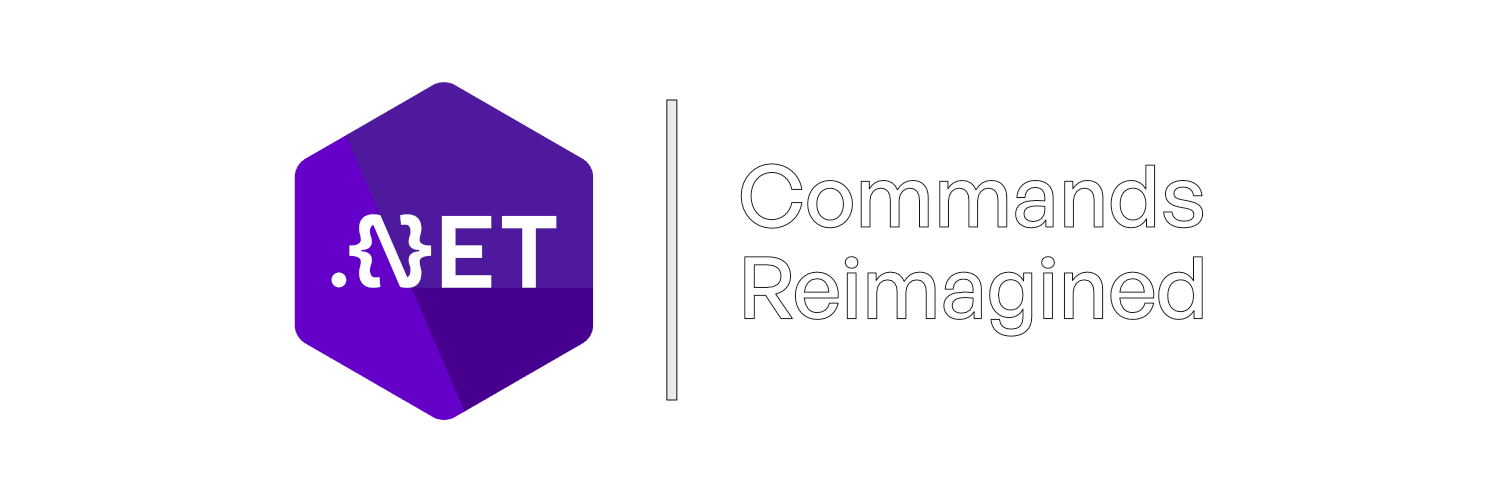Consider leaving a ⭐
Do more, with less. With speed, compatibility and fluent integration in mind.
Commands.NET aims to improve your experience integrating input from different sources* into the same, concurrent pool and treating them as triggered actions, called commands. It provides a modular and intuitive API for registering and executing commands.
*Sources can range from command-line, console, HTTP, chatboxes, to social platforms like Discord, Slack, Messenger & much, much more.
Browse the wiki for a full overview of the library.
Commands.NET is available on NuGet. You can install it using the package manager, or the following command:
dotnet add package Commands.NETAlternatively, adding it to your .csproj file:
<PackageReference Include="Commands.NET" Version="x.x.x" />Note
Commands.NET.Hosting and Commands.NET.Http are available as extension packages for respective features,
allowing you to host commands in the .NET Generic Host and expose them as HTTP endpoints.
A command is a method executed when a specific query is provided. By creating a manager to contain said command, you can run it with the provided arguments.
var provider = new ComponentProvider();
provider.Components.Add(new Command(() => "Hello world!", "greet"));
await provider.Execute(new ConsoleContext(args));
// dotnet run greet -> Hello world!Command groups are named collections of commands or other command groups. Groups allow for subcommand creation, where the group name is a category for its children.
var mathGroup = new ComponentGroup("math")
{
new Command((double number, int sumBy) => number + sumBy,
"sum", "add"),
new Command((double number, int subtractBy) => number - subtractBy,
"subtract", "sub"),
new Command((double number, int multiplyBy) => number * multiplyBy,
"multiply", "mul"),
new Command((double number, int divideBy) => number / divideBy,
"divide", "div")
};
var provider = new ComponentProvider();
provider.Components.Add(mathGroup);
await collection.Execute(new ConsoleContext(args));
// dotnet run math sum 5 3 -> 8Command modules are classes that can contain commands or nested command modules, which themselves can also contain (sub)commands.
public class PingModule : CommandModule
{
[Name("ping")]
public string Ping() => "Pong!";
[Name("pong")]
public string Pong() => "Ping!";
}
...
var provider = new ComponentProvider();
provider.Components.Add<HelpModule>();
provider.Components.Add(mathGroup);
await provider.Execute(new ConsoleContext(args));
// dotnet run help -> Commands: math sum <...> math subtract <...> math ...Commands.NET is designed to be compatible with dependency injection out of the box, propagating IServiceProvider throughout the execution flow.
var services = new ServiceCollection()
.AddSingleton<MyService>()
.AddSingleton<ComponentProvider>();
.BuildServiceProvider();
var provider = services.GetRequiredService<ComponentProvider>();
provider.Components.Add<HelpModule>();
provider.Components.Add(mathGroup);
await provider.Execute(new ConsoleContext(args), new ExecutionOptions() { Services = services });Modules can be injected directly from the provider. They themselves are considered transient service consumers, being created and disposed of per command execution.
public class ServicedModule(MyService service) : CommandModule
{
}Alongside dependency injection support in the base package, Commands.NET provides an extension package for the .NET Generic Host, allowing you to integrate Commands.NET into your application with ease.
var host = Host.CreateDefaultBuilder(args)
.ConfigureComponents(configure => ...)
.Build();The extension package supports factory-based command execution alongside scope management, allowing you to manage the lifetime of your commands and modules.
This repository includes a set of samples with documented code to help you get started with Commands.NET.
- Manage, create and execute commands in a basic console application.
- Fluent API's, complex execution flow and workflow expansion.
- Use Commands.NET in F# projects.
- Integrating Commands.NET into the .NET Generic Host infrastructure.
- Exposing commands as lightweight HTTP endpoints without the heavy lifting.
- Building Native-AOT apps with Commands.NET.
Benchmark results are found here.



